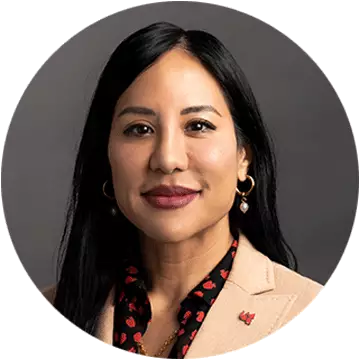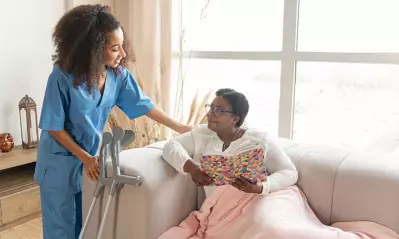Innovation in nursing and patient care
This article was updated on December 6, 2023.

Written by Elizabeth Exline

This article was reviewed by Raelene Brooks, Dean, College of Nursing.
At a glance
- A predictive model developed by Kaiser Permanente
- The healthcare industry can benefit from innovation
- Registered nurses can earn their Bachelor of Science in Nursing
Innovation in nursing
Innovation in nursing offers some obvious benefits. (Chief among these: Improved healthcare delivery in clinical settings.) Delivering innovation, however, isn’t always easy.
On the one hand, nursing requires creativity and a certain agility to innovate and provide high-quality, patient-centric care. On the other hand, healthcare is one of the most risk-averse industries around, and for good reason: Mistakes can cost lives .
But when the challenge to innovate is successfully met, the results can be profoundly beneficial. Here, two University of Phoenix nursing alumni share some ways innovations in nursing have been instrumental for improving patient care.
Why nursing is primed for innovation
If nursing has a type, it’s a no-nonsense personality with a strong independent streak. Nursing is focused on a patient’s mental, physical and psychosocial well-being. Innovation is needed to improve the quality of patient care and deliver healthcare outcomes in an efficient, practical and cost-effective way.

“We don’t have time to think about things as much or research them or mull them over. You have patients, and they need your care,” observes Mary Hancock, PhD, RNC-OB.
Hancock’s position stems from her work in academia: In addition to working as a nursing professor in West Virginia, she is also an editor of the online research journal The Qualitative Report .
In these roles, she sees a strong difference between the way academia and nursing approach issues. Where academia has the luxury of analyzing and discussing concepts or problems, nursing is focused on solutions.
“Nurses are used to doing more with less,” Hancock says.
From her observations, they’ll fix equipment themselves if at all possible. They’ll barter with other units for supplies or resources. They know how to work with all types of people, from physicians to patients.
“With that you become very creative in how you approach people, how you approach the care of your patients and your team,” Hancock explains.
Vanessa A. Martinez, DNP, MHA, RN, agrees. As the director of virtual nursing care at Kaiser Permanente in Oakland, California, Martinez points out that a “speaking-up culture” encourages innovation in any sphere, including nursing and healthcare.
In those situations, the impossible can suddenly become possible, as evidenced by an automated predictive model to proactively identify high-risk patients, which was implemented at Kaiser Permanente between 2016 and 2019. (More on that later.)
On the floor, innovation follows the same needs-must ethic Hancock espouses. This might mean taking the time to find an interpreter for a non-English-speaking patient, she says, or holding the hand of a nervous patient while helping them to calm down through breath work.
An example that stands out to Martinez for its combination of quick thinking and compassion concerns a patient who kept pulling out her IV lines during the night. Her nurse instinctively knew she needed something to help calm her, so she placed a bootie in her arms to cuddle like a stuffed toy. The patient was able to sleep; the lines stayed in.

“Nurses are natural innovators because of how we care and advocate.”
Examples of nursing innovations
Sometimes, as with the nurse who fashioned a pillow out of a bootie, innovation is born from human-to-human contact. Other times, it’s the fruit of sophisticated technology.
Remember that automated predictive model at Kaiser Permanente? It’s one such example. The program relies on a predictive algorithm developed by physician researchers at the Kaiser Permanente Division of Research , which scans almost 100 elements from patient health records hourly to identify patients who are at high-risk for decline
while in the hospital.
Known as the Advance Alert Monitor (AAM) program, it identifies high-risk patients in real time. So, rather than react to a patient when a complication arises, the AAM program gives clinicians 12 hours of lead time to respond, plan and take action.
The multidisciplinary collaboration between the virtual quality nurse consultants (VQNC) and Rapid Response Team nurses allows for standardized workflows, patient rescue, and alignment of care goals and the patient's needs near the end of life.
The AAM program predates the pandemic, but it proved useful when COVID-19 hit. By that point, it had been implemented at 21 Kaiser Permanente Northern California hospitals over two and a half years, during which time 520 deaths were avoided per year over the 3.5-year study period.
“The VQNCs moved to a hybrid workflow of reviewing the AAM alerts and care gaps to provide a holistic approach to reviewing patient care to address the influx of patients with COVID-19,” Martinez says.
Practical innovations
Thanks to technology, virtualization is positively impacting nursing on multiple levels. Martinez points to technologically advanced cameras that afford virtual access to a given patient’s condition. These cameras are installed in select patient rooms so that caregivers can examine a patient virtually.
“They can actually measure the pupils of the eyes of the patient from the camera,” she marvels. These virtual tools augment the ability to assess and support the local team on the ground with clinical decision-making.
Hancock points to less futuristic but equally impactful technology: telemedicine. It took off with the advent of the pandemic’s social distancing protocols, she says, but it’s ideal for less densely populated regions.
As standards for telehealth become more established, Hancock says innovation in nursing includes a related component: expedited licenses.
“Boards of nursing have really expedited licensures to allow nurses to come into other states who wanted either to volunteer or travel,” she says. The time to get a license can be a major hurdle for nurses, but some states have made steps to speed up the process.
In 2019, the Enhanced Nursing Licensure Compact was launched to provide nurses with a multi-state license to work in any state in the compact without having to receive a permanent license for each state. As of June 2022, 39 states are participating, drastically removing the complexities of licensure requirements.
Other states are offering walk-through state licenses as a solution. These temporary licenses can be obtained within 24 to 48 hours and allow nurses to start working in a state while their permanent license is processed. The time savings can be monumental, as some nurses were waiting three to six months to be issued new licenses in 2021.
Expedited licenses, combined with streamlined hospital orientations, means nurses and nursing students can get to work faster — and that can create more opportunities for innovation down the road.
Need for future innovation in nursing?
The future is what largely drives innovation in nursing. The next crisis, pandemic or health concern — they are what motivate the innovators of today to keep imagining possibilities.
“We’re still evolving,” Martinez says. “We’re working with our data analytics team to automate some of our information to see how we can merge some of our data collection that would benefit other teams.”
This merging of data can help enable systems to integrate. For example, pharmacists can connect their electronic records with those of nurses, physical therapists and physicians to streamline data collection and analysis (as opposed to each specialist maintaining records on separate platforms). The question that propels them is always one of improvement. How can they improve patient outcomes?
Hancock points out that one part of improving patient outcomes is ensuring the care team is properly trained and invested. Travel nursing , for example, has been attractive to professionals looking to take advantage of bigger salaries and the chance to live in a new city for a finite period of time. The trade-off? Communities are losing their nurses.
Hancock explains: “Healthcare organizations need to take a step back and really realize that they need to retain their employees and keep that knowledge there, because nurses do have a connection to the community. They understand the culture of the community, the patient population. … You lose all that when people travel.”
Innovation, after all, starts at home.
Frequently asked questions
Why is innovation important in nursing?
As evidenced by the COVID-19 pandemic, new approaches to patient care are vital. Nurse innovators had to not only optimize and sometimes pivot in their workflow, but they also had to explore and implement new treatments and protocols.
Outside of such extenuating circumstances as a pandemic, nursing innovation can result in numerous benefits, including education, disease prevention and decreased patient mortality.
How can nurses be innovators?
Martinez advocates for what she calls a “speaking-up culture” in healthcare, which empowers nurses to surface issues when they begin to percolate, suggest solutions, contribute to research and innovate.
Nurses can also innovate in practice, such as by rethinking traditional care practices. Hancock, for example, recalls how clustering care — when nurses carry out several tasks with a patient at one time instead of exiting and reentering the room multiple times — used to be the norm before it fell out of favor and then was resurrected as a best practice during the COVID-19 pandemic.
What are some benefits of innovative nurse leadership?
When nurse leaders are innovative, it creates a synergy between management and practice that, theoretically, can improve patient care and outcomes in clinical settings.

ABOUT THE AUTHOR
Elizabeth Exline has been telling stories ever since she won a writing contest in third grade. She's covered design and architecture, travel, lifestyle content and a host of other topics for national, regional, local and brand publications. Additionally, she's worked in content development for Marriott International and manuscript development for a variety of authors.

ABOUT THE REVIEWER
Dr. Raelene Brooks, dean of the College of Nursing, has been a registered nurse for more than 25 years and practiced extensively in the areas of ICU, trauma and critical care. Her publications include a focus on nursing education, critical care and diversity, equity and inclusion. She is a leader in creating, guiding and launching innovative curriculum.
This article has been vetted by University of Phoenix's editorial advisory committee.
Read more about our editorial process.
Read more articles like this:


